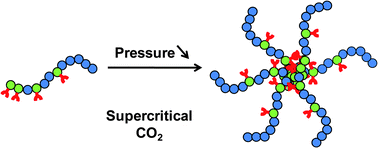SANS study of the self-organization of gradient copolymers with ligand groups in supercritical CO2†
Abstract
We report on a small-angle neutron scattering study of the self-organization of new gradient fluorinated

Maintenance work is planned for Wednesday 1st May 2024 from 9:00am to 11:00am (BST).
During this time, the performance of our website may be affected - searches may run slowly and some pages may be temporarily unavailable. If this happens, please try refreshing your web browser or try waiting two to three minutes before trying again.
We apologise for any inconvenience this might cause and thank you for your patience.
* Corresponding authors
a Institut Charles Gerhardt – UMR 5253 CNRS/UM2/ENSCM/UM1, Ingénierie et Architectures Macromoléculaires (IAM), ENSCM, 8 rue de l'Ecole Normale, Montpellier Cedex 5, France
b Institut de Chimie Séparative de Marcoule, UMR 5257, ICSM Site de Marcoule, BP 17171, Bagnols Sur Cèze Cedex, France
c
Laboratoire des colloïdes, verres et nanomatériaux (LCVN)- UMR 5587 CNRS-UM2, Université Montpellier II, place Eugène Bataillon, Montpellier Cedex 5, France
E-mail:
oberdisse@lcvn.univ-montp2.fr
Fax: (+33) 467144637
Tel: (+33)467143523
d Laboratoire Léon Brillouin, UMR 12 CEA/CNRS, Centre d'Etudes de Saclay, Gif-sur-Yvette Cedex, France
e CEA Marcoule DEN/DTCD/SPDE/Laboratoire des Fluides Supercritiques et Membranes (LFSM), BP17171, Bagnols Sur Cèze Cedex, France
We report on a small-angle neutron scattering study of the self-organization of new gradient fluorinated

 Please wait while we load your content...
Something went wrong. Try again?
Please wait while we load your content...
Something went wrong. Try again?
T. Ribaut, J. Oberdisse, B. Annighofer, I. Stoychev, B. Fournel, S. Sarrade and P. Lacroix-Desmazes, Soft Matter, 2009, 5, 4962 DOI: 10.1039/B912268K
To request permission to reproduce material from this article, please go to the Copyright Clearance Center request page.
If you are an author contributing to an RSC publication, you do not need to request permission provided correct acknowledgement is given.
If you are the author of this article, you do not need to request permission to reproduce figures and diagrams provided correct acknowledgement is given. If you want to reproduce the whole article in a third-party publication (excluding your thesis/dissertation for which permission is not required) please go to the Copyright Clearance Center request page.
Read more about how to correctly acknowledge RSC content.
 Fetching data from CrossRef.
Fetching data from CrossRef.
This may take some time to load.
Loading related content
